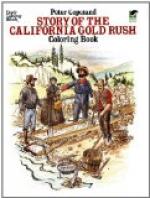[Illustration: INDIAN WOMAN WITH PAPPOOSE.]
[Illustration: INDIAN WOMAN WITH BASKETS.]
But they had no idea of saving food, so they fattened when there was plenty, and starved when dry years made the acorns or nuts scarce. Having no salt, they did not try to dry or smoke the meat of deer or other wild animals. Nor did they at first lay up nuts and seeds, as even the squirrels or woodpeckers do, for winter use. But wandering from place to place, they camped in the summer along the rivers, where fish was plenty and the wild oats gave them grain. In the fall they hunted pine-nuts and berries in the mountains, till snow drove them down into the valleys.
Each Indian town, or rancheria, had a name, and many of these names are still in use. At the north lived the Klamaths, Siskiyous, Shastas, and the savage Modocs, whose months of fighting in the lava beds caused the death of General Canby and many soldiers. The Porno tribes of Lake county, Yrekas, Hoopas, and Ukiahs, are well known at the present day. Tehama, Colusa, Tuolumne, Yosemite, and other places recall the Indians who gave each its name. The San Diego Indians are still known as Dieguenos and live on a reserve, or lands set aside for them.
Almost all the natives had Indian money, called wampum, which they made from abalone or clam-shells by cutting out round pieces like buttons or small, hollow beads. Little shells were also used, and the wampum was strung on grass or on deer sinews. The Pomos still make thousands of pieces of this money, and so many strings of it will buy whatever the buck, or Indian man, and his mahala, or squaw, wish to get.
General Bidwell, who came to California in 1841 and surveyed the land for many ranches, says of the Indians at that time:—
“They were almost as wild as deer, and wore no clothes at all except the women, who had tule aprons fastened to a belt round their waists. In the rough work of surveying among brush and briars I gave the men shoes, pantaloons, and shirts, which they would take off when work was done, carry home in their hands, and put on in time to go to work again. But they soon learned to sleep in their new things to save trouble, and would wear them day and night till a suit dropped to pieces. They were quick to do as the whites did, and when paid in calico and cloth Saturday night, by Monday they had on their new skirts or shirts all made up like ours. Yet every Indian would choose beads for his wages, and go almost naked and hungry till the next pay-day.”
General Bidwell treated the Indians honestly and kindly, and in return they were his friends and helped him much to his advantage. In 1847 he settled on the great Rancho Chico, and part of his land he gave to the Mechoopdas, as the Indian rancheria there was called. They worked to plant orchards and at all his farm-work, and he treated them so fairly that old men are still living on this ranch who as boys helped the general in his tree-planting and road-building. A whole village of these Mechoopdas live on the Bidwell place owning their houses, while Mrs. Bidwell is their best friend and helps them in sickness and trouble. The men work in the hop fields and fruit orchards, and the women make baskets.




